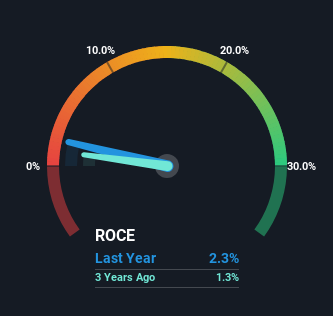- Saudi Arabia
- /
- Chemicals
- /
- SASE:2010
Saudi Basic Industries (TADAWUL:2010) Is Finding It Tricky To Allocate Its Capital

When researching a stock for investment, what can tell us that the company is in decline? More often than not, we'll see a declining return on capital employed (ROCE) and a declining amount of capital employed. This indicates to us that the business is not only shrinking the size of its net assets, but its returns are falling as well. On that note, looking into Saudi Basic Industries (TADAWUL:2010), we weren't too upbeat about how things were going.
Understanding Return On Capital Employed (ROCE)
For those who don't know, ROCE is a measure of a company's yearly pre-tax profit (its return), relative to the capital employed in the business. Analysts use this formula to calculate it for Saudi Basic Industries:
Return on Capital Employed = Earnings Before Interest and Tax (EBIT) ÷ (Total Assets - Current Liabilities)
0.023 = ر.س5.8b ÷ (ر.س300b - ر.س48b) (Based on the trailing twelve months to June 2023).
So, Saudi Basic Industries has an ROCE of 2.3%. In absolute terms, that's a low return and it also under-performs the Chemicals industry average of 7.4%.
See our latest analysis for Saudi Basic Industries

In the above chart we have measured Saudi Basic Industries' prior ROCE against its prior performance, but the future is arguably more important. If you'd like, you can check out the forecasts from the analysts covering Saudi Basic Industries here for free.
What Does the ROCE Trend For Saudi Basic Industries Tell Us?
We are a bit worried about the trend of returns on capital at Saudi Basic Industries. To be more specific, the ROCE was 13% five years ago, but since then it has dropped noticeably. And on the capital employed front, the business is utilizing roughly the same amount of capital as it was back then. Companies that exhibit these attributes tend to not be shrinking, but they can be mature and facing pressure on their margins from competition. If these trends continue, we wouldn't expect Saudi Basic Industries to turn into a multi-bagger.
The Bottom Line
In the end, the trend of lower returns on the same amount of capital isn't typically an indication that we're looking at a growth stock. It should come as no surprise then that the stock has fallen 26% over the last five years, so it looks like investors are recognizing these changes. Unless there is a shift to a more positive trajectory in these metrics, we would look elsewhere.
If you'd like to know about the risks facing Saudi Basic Industries, we've discovered 2 warning signs that you should be aware of.
While Saudi Basic Industries may not currently earn the highest returns, we've compiled a list of companies that currently earn more than 25% return on equity. Check out this free list here.
New: Manage All Your Stock Portfolios in One Place
We've created the ultimate portfolio companion for stock investors, and it's free.
• Connect an unlimited number of Portfolios and see your total in one currency
• Be alerted to new Warning Signs or Risks via email or mobile
• Track the Fair Value of your stocks
Have feedback on this article? Concerned about the content? Get in touch with us directly. Alternatively, email editorial-team (at) simplywallst.com.
This article by Simply Wall St is general in nature. We provide commentary based on historical data and analyst forecasts only using an unbiased methodology and our articles are not intended to be financial advice. It does not constitute a recommendation to buy or sell any stock, and does not take account of your objectives, or your financial situation. We aim to bring you long-term focused analysis driven by fundamental data. Note that our analysis may not factor in the latest price-sensitive company announcements or qualitative material. Simply Wall St has no position in any stocks mentioned.
About SASE:2010
Saudi Basic Industries
Engages in the manufacture, marketing, and distribution of chemicals, polymers, plastics, agri-nutrients, and metal products worldwide.
Flawless balance sheet with reasonable growth potential.


